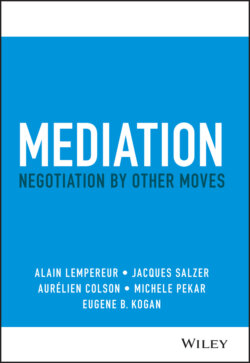Читать книгу Mediation - Alain Lempereur - Страница 25
Institutional Mediators
ОглавлениеHere, mediators are part of a mediation organization, which guarantees continuity. The mediators are formally employed by an organization (public body, company, etc.) and its external partners (consumer, user, customer, supplier, etc.) seeking to rectify a complaint that they find justified in law or in equity. In addition, large organizations have appointed mediators in charge of managing internal disputes among their stakeholders.
We owe the invention of institutional mediators to the Swedes, who created the ombudsman in 1809: a man in charge of a mission (ombuds), in this case the search for justice between the State and its citizens. A similar function has developed in neighboring Nordic countries, such as Finland in 1953, then in the United Kingdom and the United States in the 1960s. In 1973, France created the Mediator of the Republic to facilitate disputes between the government and its citizens. Many universities have created ombuds services.
Why appoint institutional mediators? The intention is to establish a human link between an individual and an organization, which at first glance looks like a bureaucratic machine. Even in organizations that strive to respect rights, an individual might feel lost or powerless, when faced with decisions that seem unfair or seem to impinge on their rights. In these cases, mediators can help to exercise, between a person and an organization, an ex post review of the quality of the decisions. Even if the organization appoints and remunerates the mediators, it needs to guarantee their independence of judgments and actions, for them to seek fair solutions between the organization and the applicant. In fact, taking into account the current craze for mediation, such services will only serve the long‐term image of an organization, if they also benefit from real resources and skills (Lempereur 1998b). Many leaders of organizations sincerely appreciate that “their” institutional mediators exercise critical functions and contribute to conflict reduction and to stakeholders' improved satisfaction.
Whichever organization hosts them, institutional mediators generally employ a method characterized by the following:
Written mediation, carried out on the basis of a complaint reported by one stakeholder (for example, the employee or the user on one side, the department concerned on the other).
A compliance review of contractual rules or established law.
A fairness test that mediators perform.
An opinion of the mediator (or of the mediation commission), which makes suggestions that the parties remain free to follow or not. This advice sometimes paves the way for a new negotiation.
An additional advantage of institutional mediators lies in their ability to recommend, within their organization, the implementation of the solution advocated at the end of the mediation they just conducted. There is thus a coherence between the problem posed, the proposed solution, and the people or organizations involved in the implementation of this solution.
Institutional mediation also aims to propose generalizable solutions, fully integrating the possibility that they constitute precedents that can be referred to later. Because of their role, institutional mediators inevitably reveal patterns in the interpretation of, and solutions to, some recurrent conflicts; as a result, they create some predictability of outcome. In addition, they derive recommendations from their activity, which they communicate where appropriate within their organization, or even make public in annual reports. These recommendations often help to revamp organizational structures and procedures.
Finally, in general, it is the institutional mediator (and not the parties) who proposes solutions in the form of opinions or recommendations. Institutional mediators thus fit into the “mediator as adviser” model that we will develop next. As evidenced, this typology of mediators – informal, ad hoc, institutional – echoes a diversity of mediation practices.
